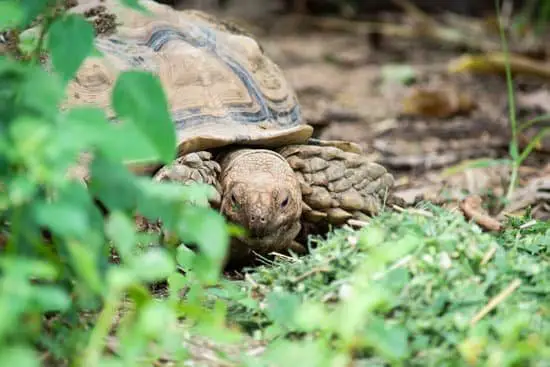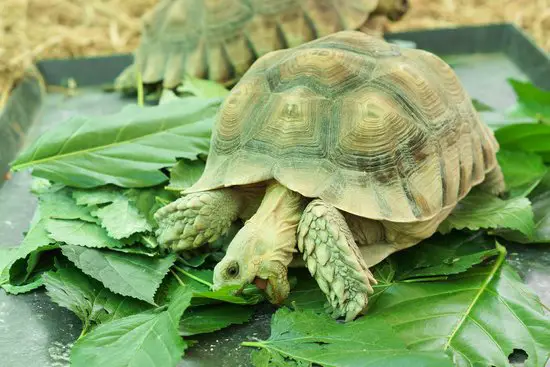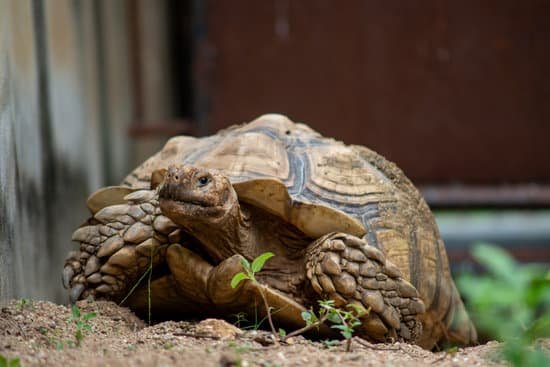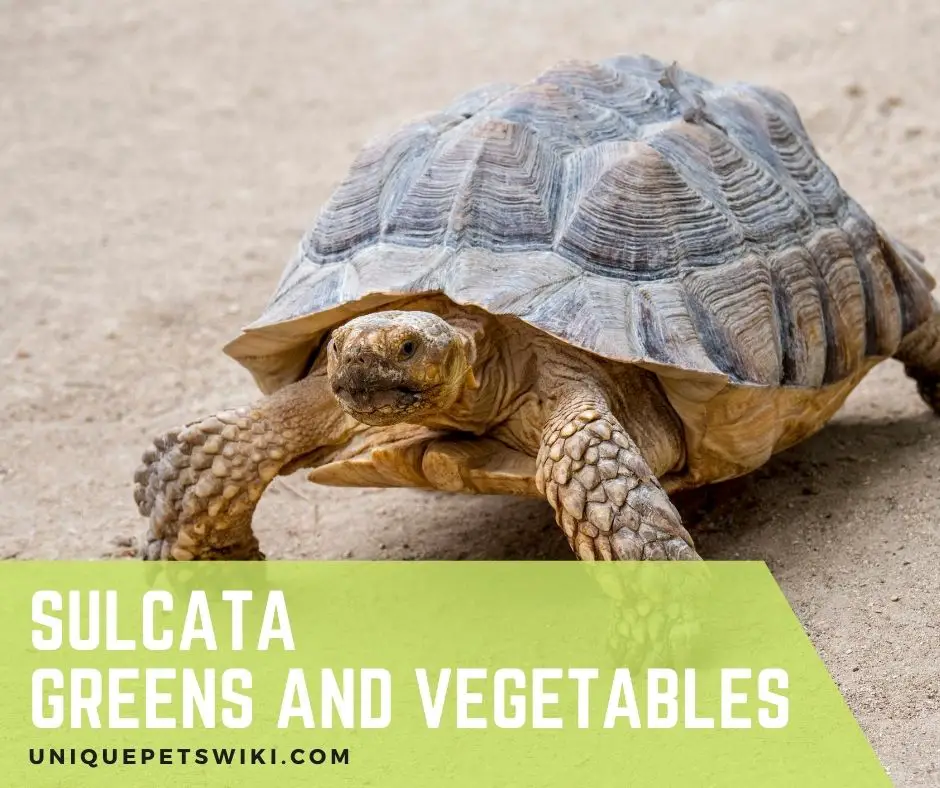Greens and vegetables are an essential part of Sulcata’s diet. And Sulcatas can eat a variety of available plants and vegetables.
However, some, even though edible to Sulcatas, can be harmful to them if consumed regularly.
Therefore, it would be best to understand which greens and vegetables are suitable to include in your Sulcata diet.
For this reason, we came up with this article to help you understand what and how much greens and vegetables you should include in your Sulcata’s diet.
Remember, exotic pets depend on their owners to provide a healthy diet. An improper diet can cause ill health as well as shorten your Sulcata’s lifespan.
Therefore, keep reading to stay on the know and avoid committing wrong diet choices that can cause harmful health and death to your Sulcata.
Contents
What Vegetables Can Sulcata Tortoises Eat?

Sulcata’s diet should include at least 10-15% of vegetables. Vegetables are good sources of calcium and vitamins. However, some vegetables contain high oxalic acid that binds to calcium, preventing it from being absorbed. Also, some vegetables contain no nutritional value.
Therefore, it is critical to understand what vegetables you should include or avoid when feeding your Sulcata tortoise. Remember, Sulcata tortoises are like eating machines. They will, therefore, feed on everything you offer to them even though it’s harmful.
It is, therefore, your responsibility as a Sulcata tortoise owner to choose suitable vegetables that do not have any health risks to your pet.
Some of the best vegetables to offer your Sulcata include carrots, kales, green beans, endive, and turnip greens.
When feeding vegetables to your Sulcata tortoise, it would be best to provide them with a dish to prevent them from ingesting sand or gravel. Sand and gravel ingestion causes Sulcata tortoises to suffer from impaction.
What Greens Can Sulcata Tortoises Eat?

Greens are also part of the Sulcata tortoise diet. They provide calcium and vitamin in Sulcata tortoises.
Luckily, Sulcatas, with their voracious appetite, can consume almost every green plant. However, Sulcata tortoises only require small portions of these green leafy plants.
Therefore, it is necessary for you to regulate how much green plant to feed your Sulcata tortoise.
Additionally, not all greens are useful to Sulcatas. Some such as kales, rhubarb, collard, and parsley are not suitable as they contain high oxalates.
Therefore, you should only feed a small portion of the best greens to your Sulcata. A good thumb rule is to provide only 1-5% of these greens.
Some of the best greens to offer your Sulcata include mustard, turnip, and dandelion, among others.
Sulcata Tortoise Greens and Vegetables Diet Chart

Sulcata tortoises can consume almost all vegetables and greens. They do not know how to differentiate a good diet from a bad one. And, too much or too little greens and vegetables can cause health issues in Sulcata.
It is your responsibility to offer them a good diet and in the right portion. For this, here is a table showing what, how much, and how often greens and vegetables you should feed your Sulcata tortoise.
| Greens To Sulcata | % Diet | How often to feed Sulcata |
| Chicory | 10-15% | You can feed regularly |
| Endive | 10-15% | You can feed regularly |
| arugula | 10-15% | You can feed regularly |
| Grape leaf | 10-15% | You can feed regularly |
| Green oak leaf | 10-15% | You can feed regularly |
| Kale | 1-5% | Feed occasionally |
| Bok Choy | 1-5% | Feed occasionally |
| Collard greens | 1-5% | Feed occasionally |
| Mesclun lettuce | 10-15% | You can feed regularly |
| Radicchio | 10-15% | You can feed regularly |
| Red leaf lettuce | 10-15% | You can feed regularly |
| Turnip leaf | 1-5% | Feed occasionally |
| Spinach | 1% | Feed sparingly |
| Watercress | 10-15% | Can include in every meal |
| Romaine | 1-5% | Feed occasionally |
| Spring Mix lettuce | 10-15% | You can feed regularly |
| Rhubarb | 1-5% | Feed sparingly |
| White, red, and purple clovers | 10-15% | You can feed regularly |
| Mulberry leaves | 10-15% | You can feed regularly |
| Grape leaves | 10-15% | You can feed regularly |
| Cactus pads | 10-15% | You can feed regularly |
| Mallow | 10-15% | You can feed regularly |
| Dandelions | 10-15% | You can feed regularly |
| Beet greens | 1-5% | Feed occasionally |
| Parsley | 1-5% | Feed occasionally |
| Chard | 10-15% | You can feed regularly |
| Sprouts | 10-15% | You can feed regularly |
| Lamb’s lettuce | 10-15% | You can feed regularly |
| Edible flowers | 10-15% | You can feed regularly |
| Radish tops | 10-15% | You can feed regularly |
| Curly lettuce | 10-15% | You can feed regularly |
| Peacock poppy | 10-15% | You can feed regularly |
| Blackberry | 10-15% | You can feed regularly |
| Flowering maple | 10-15% | You can feed regularly |
| Butterfly bush | 10-15% | You can feed regularly |
| Pot marigold | 10-15% | You can feed regularly |
| Wild carrot | 10-15% | You can feed regularly |
| Dahlia | 10-15% | You can feed regularly |
| Meadow fescue | 10-15% | You can feed regularly |
| Daylilies | 10-15% | You can feed regularly |
| Goat’s beard | 10-15% | You can feed regularly |
| Raspberries | 10-15% | You can feed regularly |
| Mullein | 10-15% | You can feed regularly |
| Oregano | 10-15% | You can feed regularly |
| Hibiscus | 10-15% | You can feed regularly |
| Black medick | 10-15% | You can feed regularly |
| Ice plants leaves | 10-15% | You can feed regularly |
| Reed fescue | 10-15% | You can feed regularly |
| Basil | 10-15% | You can feed regularly |
| Vegetables For Squirrels | % Sulcata Diet | How Often To Feed |
| Cabbage | 10-15% | You can feed regularly |
| Grated raw carrots | 10-15% | You can feed regularly |
| Sweet potatoes | 1-5% | Feed occasionally |
| Pumpkin | 1-5% | Feed occasionally |
| Broccoli | 1% | Feed sparingly |
| Corn on the cob | 10-15% | You can feed regularly |
| Bell peppers | 1-5% | Feed occasionally |
| Cucumber | 1-5% | Feed occasionally |
| Celery | 1-5% | Once a week |
| Cauliflower | 1-5% | Once a week |
| Mushrooms | 1-5% | Feed occasionally |
| Zucchini | 10-15% | You can feed regularly |
| Squash | 10-15% | You can feed regularly |
| Potato | 1% | Feed sparingly |
| Brussels sprouts | 1% | Feed sparingly |
| Chives | 1% | Feed sparingly |
| Eggplant | 1% | Feed sparingly |
| Peas | 1% | Feed sparingly |
| Onion | 1% | Feed sparingly |
| Parsnip | 1% | Feed sparingly |
| Tomato | 1% | Feed sparingly |
| Yams | 1% | Feed sparingly |
| Cow parsley | 10-15% | You can feed regularly |
| Portabella mushroom | 10-15% | You can regularly |
| Beetroot | 1% | Feed sparingly |
| Asparagus | 1% | Feed sparingly |
| Watermelon leaves | 10-15% | You can feed regularly |
| Aloe | 10-15% | You can feed regularly |
| Crested dog tail | 10-15% | You can feed regularly |
| Nettle | 10-15% | You can feed regularly |
| White clover | 10-15% | You can feed regularly |
| Fig leaves | 10-15% | You can feed regularly |
| Asian greens | 10-15% | You can feed regularly |
| Capsicum | 1-5% | You can feed occasionally |
| Courgettes | 1% | Feed sparingly |
| Indian vegetables | 1% | Feed sparingly |
| Kale and Cavolo Nero | 1% | Feed sparingly |
| Microgreens leaves | 10-15% | You can feed regularly |
| Okra | 10-15% | You can feed regularly |
| Puha leaves | 1% | Feed sparingly |
| Silverbeet – korare | 1% | Feed sparingly |
| Witloof | 10-15% | You can feed regularly |
| Alfalfa sprouts | 10-15% | You can feed regularly |
| Azuki beans | 1% | Feed sparingly |
| Anise | 1% | Feed sparingly |
| Fennel | 1% | Feed sparingly |
| Lavender | 1% | Feed sparingly |
| Thyme | 1% | Feed sparingly |
| Paprika | 1% | Feed sparingly |
| Tabasco pepper | 1% | Feed sparingly |
| Tat soi | 1% | Feed sparingly |
| Horseradish | 1% | Feed sparingly |
| Cayenne pepper | 1% | Feed sparingly |
| Broccoli Raab | 1-5% | Feed occasionally |
| Corn | 1-5% | Feed occasionally |
| Dill | 1-5% | Feed occasionally |
| French sorrel | 1-5% | Feed occasionally |
| Toxic plains for Sulcata | How often to feed? |
| Azalea | Never feed |
| Aconite | Never feed |
| Autumn crocus | Never feed |
| Black locust | Never feed |
| Boxwood | Never feed |
| Buttercup | Never feed |
| Butterfly weed | Never feed |
| Calla | Never feed |
| Castor bean | Never feed |
| Cherry laurel | Never feed |
| Daffodil | Never feed |
| Elephant ears | Never feed |
| Foxglove | Never feed |
| Heavenly bamboo (nandina) | Never feed |
| Horse nettle | Never feed |
| Gloriosa lily | Never feed |
| Iris | Never feed |
| Hyacinth | Never feed |
| Lantana | Never feed |
| Lilly of the valley | Never feed |
| Marsh marigold | Never feed |
| Trumpet flower | Never feed |
| Tobacco | Never feed |
| Wild cherry | Never feed |
| Yellow allamanda | Never feed |
| Spring Adonis | Never feed |
| Nightshade | Never feed |
Wrapping Up
Sulcata tortoises are hardy and easy to keep, even for beginners. Keeping them happy and healthy mostly depends on what you feed them.
One of the most common mistakes that tortoise keepers make is overfeeding and feeding the wrong diet.
Since reptiles have slow metabolisms compared to mammals like dogs and cats, it would be best to feed them small portions of food.
Overfeeding and the wrong choice of diet can cause significant health issues to Sulcatas.
Therefore, you should study the above list of edible vegetables and greens to avoid making such mistakes.
We wish you all the best with your Sulcata tortoise.
